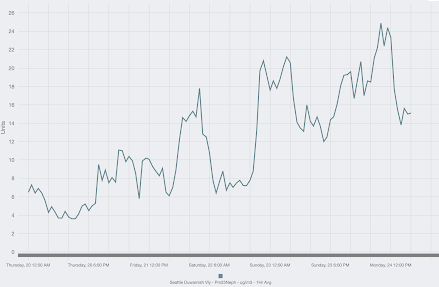Air Quality Declines As Inversion Slowly Weakens Overhead
Inversions, in which temperatures INCREASE with elevation, suppress vertical mixing, which in turn allows pollutant concentrations to increase near the surface.
And with a strong inversion over western Washington and Oregon the last few days, air quality has degraded to moderate levels at several locations.
To illustrate, below is a map (at 7 PM today) showing the concentrations of small particles (less than 2.5 millionths of a meter) that are capable of passing deep into your lungs. Nasty stuff.
Low concentrations are green, with moderate values in yellow and orange, and red being even higher. The Puget Sound region has degraded air quality and it is even worse around Portland. Generally good in the mountains.
You can see the declining trend of air quality in Seattle with a plot of the small particle concentration during the past few days (below). A progressive upward trend in small particles.
The sources of the particles include combustion from heating, burning of gas and diesel fuels in cars, and from burning wood in fireplaces and wood stoves.
During most winter days, these emissions are little problem around here, with stormy, wind conditions and an atmosphere that facilitates vigorous vertical mixing of air in the lower atmosphere.
But during the last three days, high pressure aloft has produced a well-defined inversion, as noted in the vertical sounding at Quillayute this morning at 4 AM. (Quillayute is on the northern WA coast)--see below. Red is temperature, the x-axis indicates temperature (°C) and the y axis is height in pressure (700 is about 10,000 ft)
You can think of an inversion as a meteorological barrier to air motion. Here is a beautiful example of what happens when smoke hits a low-level inversion (see below).... it is like hitting an invisible barrier.
The good news is that our winter concentrations are getting lower and lower, as fewer homes burn wood (very dirty), cars and trucks get cleaner, electric cars become more numerous, and with effective burn bans and other restrictions by air quality groups like the Puget Sound Clean Air Agency.
And some other good news...the inversion is weakening and will probably break later today--maybe even with a glimpse of the sun. And stormier conditions will return on Friday.
Prepare to take a deep, healthful breath!







Comments
Post a Comment